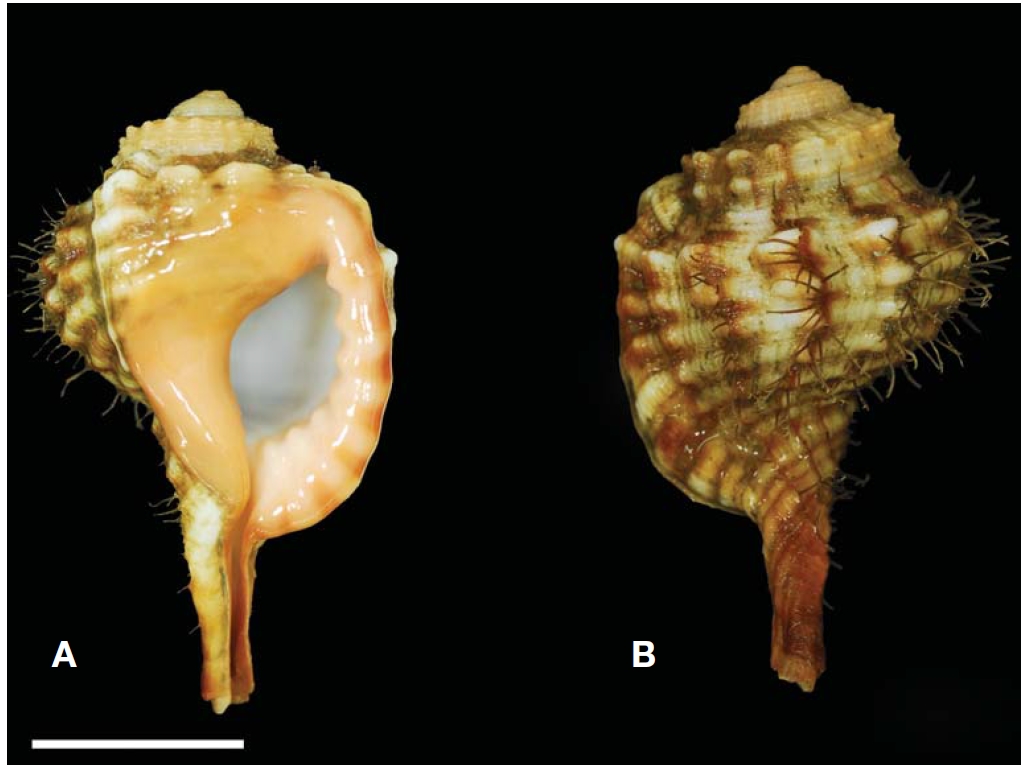The Cymatium Roding, 1798 is a small- to large-sized marine gastropod genus, ranging from a few cm to nearly 20 cm in shell height. It contains approximately a hundred species (the number of species is variable according to the taxonomic authorities), many of which are found in tropical waters (Henning and Hemmen, 1993). Cymatium is carnivorous that normally feeds on a variety of invertebrates, such as tube worms, ascidians, and other bivalve mollusks, including clams and oyster species (Houbrick and Fretter, 1969; Littlewood, 1989; Govan, 1995). The external morphology of this genus is characterized by having a club-shaped shell with an ornamentation of knob, spiral ribs, and axial varices. To date, three Cymatium species have been reported in the Korean waters: Cymatium parthenopeum echo Kuroda and Habe, 1961, C. comptum (Adams, 1855), and C. tenuiliratum (Lischke, 1873).
In this study, we report a new record of Cymatium encausticum (Reeve, 1844) in the Korean waters, providing a description of the species with illustration for the shell morphology. A single individual of the species was collected from Jejudo Island at a depth of 9 meters by SCUBA diving on November 2010 and transferred to the laboratory after a fixation in 95% ethanol. Morphological features were observed using a stereomicroscope (Leica MZ12.5, Germany). The specimen used in this study was deposited (registration no. G00000106) in the Marine Mollusk Resources Bank of Korea (MMRBK) at Chungbuk National University in Korea.
Class Gastropoda Cuvier, 1797
Superfamily Tonnoidea Suter, 1913
Family Ranellidae Gray, 1854
Subfamily Cymatinae Iredale, 1913 (1854)
Genus Cymatium Roding, 1798
1* Cymatium encausticum (Reeve, 1844) (Fig. 1)
Triton encausticus Reeve, 1844: P1. 12, fig. 43.
Cymatium pyriformia: Yen, 1942: 215, Pl. 18, fig. 111.
Ranularia encaustica: Habe, 1964: 72, Pl. 22, fig. 15.
Cymatium (Ranularia) encausticum: Beu, 1986: 296, figs. 78- 80; Henning and Hemmen, 1993: 77, Pl. 16, fig. 1; Poppe, 2008: 648, Pl. 269, figs, 4, 5.
Material examined. 1 individual (collected alive), Jeju-do, Seogwipo-si, Beophwan-dong, Beomseom, depth of 9 m by scuba diving, 6 Nov 2010.
Measurement. Shell height 57.7 mm; shell width 32.8 mm.
Description. Shell solid, club-shaped, whitish brown in color; spire very short accounting for less than 1/4th of shell height; each whorl with thick spiral ribs crossed by axial cords, making the shoulder angulated; body whorl well-developed having 11 axial ribs covered with dark-brown, bristled periostracum; aperture ovate with a prominent posterior canal; parietal wall strongly calloused, extending to shoulder of penultimate whorl; outer lip very thick, red-yellow with seven nodules extending inside outer lip; siphonal canal markedly long (accounting for almost 1/3rd of shell height), narrow, and noticeably recurved backward.
Habitat. Bedrock of 5-10 m deep.
Distribution. Philippine, Taiwan, Vietnam, Japan, and Korea (Jejudo Island).
Remarks. This species is similar to its congener C. gutturnium (Roding, 1798) in size and general appearance, but differs from it in a suit of apertural features: the callus of parietal lip in C. encausticum is much more developed, reaching into the shoulder of the penultimate whorl, than in any other congeneric species, including C. gutturnium. The axial ribs of this species are less prominent that those found in C. gutturnium. This species has been known to occur with C. gutturnium, C. springsteeni, and C. exile, mostly in tropical seawaters including the Philippine Islands (Beu, 1986). This is the first case report of its occurrence in the Korean waters.
Korean name: 1*곤봉수염고둥(신칭)




